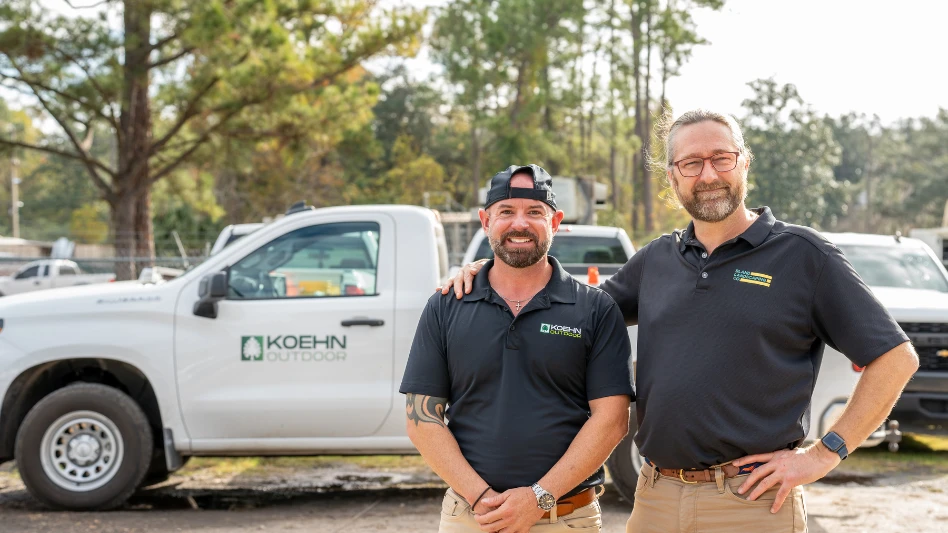 ©iStockphoto.com/geopaulDespite the down economy, mergers and acquisitions activity has continued apace for the green industry. Buoyed by an influx of investment capital from private-equity firms, companies like Yellowstone Landscape Group, the Brickman Group and ValleyCrest Cos. have been on a shopping spree, picking up big-name companies and people to position themselves for an eventual economic turnaround.
©iStockphoto.com/geopaulDespite the down economy, mergers and acquisitions activity has continued apace for the green industry. Buoyed by an influx of investment capital from private-equity firms, companies like Yellowstone Landscape Group, the Brickman Group and ValleyCrest Cos. have been on a shopping spree, picking up big-name companies and people to position themselves for an eventual economic turnaround.
Brian Corbett, managing partner at CCG Advisors, Atlanta, worked on the deal between Austin Outdoor and Plano, Texas-based Yellowstone that was announced in January. He says the increased interest from private equity firms could be a boon for business owners, and the industry as a whole.
“It means opportunity. If you’re a guy running a business that’s not going to the next generation, the fact that there’s equity money looking to get into the industry allows for more buyers and, you’d think, more deals,” Corbett says.
And when private equity gets involved, Corbett says, they aren’t usually content to sit on the sidelines. Gridiron Capital started Yellowstone in April of 2008 and simultaneously bought Piedmont in Atlanta and Bio Landscaping in Houston. Then they added Austin Outdoor, West Palm Beach, Fla.-based Dolphin Landscape and Outdoor Environments, in Houston, this year.
“They don’t buy to watch (things) grow organically,” he says. “They get active looking at targets and go about buying more companies.”
Private Equity Investment
Corbett says the landscape industry has had some level of private equity for years, especially the larger national companies like Brickman and ValleyCrest. But now, more funds are looking at the green industry because the companies – especially high-end commercial maintenance companies – bring in recurring revenue.
And while 2009 wasn’t the best, the industry has growth potential.
“If I have a company cutting my grass versus the Ritz-Carlton, I might cut my grass myself,” Corbett says. “The Ritz-Carlton is not going to do that. They have a very solid base of b2b relationships that gives them comfort to being somewhat recession-proof.”
But the industry has some negatives to investment companies: the low barriers to entry mean there is always a lot of competition and downward price pressure. Private-equity firms also are sometimes concerned with federal immigration policies, and with some companies’ reliance on big construction and installation projects.
Why are They Buying?
The increased investment comes from increased attention to the landscaping market. When big players like Brickman and ValleyCrest started getting capital infusions from private equity, it piqued the interest of outside investors.
Besides a strong service mix, private equity companies buy landscaping companies because the contractors have people the investors want. Investment firms are designed to make money, not manage mowing crews. They want a company’s management to stick around and run the business, Corbett says.
“Gridiron in Connecticut, Yellowstone in Dallas, Texas – there’s a handful of people in it; there’s no bench, there’s no platform, if you will, to plug each of these companies into. If those guys are not willing to stick around and committed to sticking around … and rolling some equity over into the business … then the private-equity groups probably aren’t as interested,” he says.
It’s the same when landscape companies look to acquire other green industry businesses. “ValleyCrest has the largest fleet in the world,” Corbett continues. “They’re not going to buy a company to pick up the accounts and the equipment. What you’re really buying is people. The people and their track record and what they’re willing to do post closing is really why they’re coming to the table.”
Corbett says the recession, while tough on operations, doesn’t necessarily mean fire-sale prices for buyers. Valuations are still determined by a company’s financial health and its market.
“It’s really a function of how’s your business doing, and what’s available,” he says.
Judy Guido, a green industry consultant, has worked for the industries heavyweights. She was chief marketing officer and a vice president at ValleyCrest, an executive team member at TruGreen and sits on Yellowstone’s board. She said the recession hasn’t dampened the market; anyone who was going to buy still is.
“I don’t think right now what’s going on as it relates to mergers and acquisitions is anything different than a normal M&A process or strategy would be,” Guido says. “Companies who buy companies, and have purchased them in the past, or that’s their business model like an equity firm, much like any business foundation, they really don’t change their principles in how or why they buy.”
But a tightening of credit has made larger purchases harder to finance. Now, instead of financing two-thirds of the selling price, buyers might have to put up as much as 70 percent of the price as equity, Corbett says. A larger up-front investment can make private-equity groups hesitant to buy, or look for lower prices.
“Everybody’s affected by the lending,” he says. “(The rules are) not as black and white as they used to be.”
Mark Long, a partner in the Ohio-based BlueSky Group, says even with tight credit, companies are still buying.
“There is activity. One might think that given the state of the credit market and the state economy overall that nothing’s going on. It’s not at record levels, but there is activity there,” he says.
So, You Want to Sell
Business owners who want the best price for their companies should focus on a few key points. They aren’t hard to figure out, consultants say, and any owner would do well to implement them regardless.
“The thought in preparing business is getting an honest, market-based understanding of how the business will be valued and what will make it most attractive,” Corbett says.
“We’re not emotional about it; it’s not our baby. We’re not going to call your baby ugly,” he adds. Many owners can lose sight of the true valuation of the companies they built: bottom-line profitability, the service mix and the strength of the management team.
Too often, he says, business owners focus on the multiple of revenue EBITDA they stand to receive. “That’s that massive oversimplification,” he says.
Buyers look for a strong base of recurring revenue (read: maintenance contracts) with a low rate of customer turnover. The better your business is run, the better.
“What is the curb appeal of the business?” Long asks. “Does it appear to be a clean, well-run, professional business?” You should document things like how things run in your business, how stable your workforce is, how many customers you have, what services make money and how much money they make.
“You need to increase the transparency of the business information,” Long says. “Transparency’s absolutely critical. If a buyer has questions … they’re immediately going to start discounting it.”
So, You Want to Buy
Guido says companies interested in acquiring other firms should take advice attributed to Rupert Murdoch: Buy great brands, because any company that has developed a great brand has its fundamentals – a strong business model, good reputation and a competitive advantage – already in place.
“I don’t care what the economic landscape looks like,” Guido says. “People who are going to acquire companies, those are going to be the key fundamentals they’re going to look at. Those things, to me, never change. Depression, recession, boom times – I can’t ever remember someone swaying away from the fundamentals of the company. This market doesn’t have any bearing on how intelligent companies who acquire will go about that process.”
Predictions for 2010
Long, who spent more than three decades with TruGreen and Scotts Lawn Service, predicts a more active M&A market next year. He points to a recovering – albeit slowly – economy, and the eventual softening of the credit markets.
“It’s not going to be a return to the ’90s or the early parts of this decade where you’re going to have two or three industry buyers competing. But, it’s going to be at least equal to if not slightly more active than 2009,” he says.
Long says consolidation absorbed many “attractive targets” in the $5 million to $10 million range. The lawn care industry has now been split into two camps: a lot of smaller companies and a few very large ones.
Corbett says the industry will see more activity next year than in 2009, as a rebounding economy allows larger companies to spend more, and as business owners look to cash in on a low capital gains tax rate that’s scheduled to increase at the end of 2010. But, even if they’re spending again, they still remember the recession, and will be more selective in whom they buy.
“I think there’s a lot of stuff coming. M&A is going to be frothy in 2010. Landscaping seems to be perfectly positioned to play a big part in that,” Corbett says. “The volume could be as high as it was a couple years ago, but I think because of the change in the underlying financial structure of the economy, it will be more measured. It’s a much more disciplined approach on behalf of the buyers. The stragetics have gotten really smart.”
The author is associate editor of Lawn & Landscape magazine. Send him an e-mail at cbowen@gie.net.

Explore the November 2009 Issue
Check out more from this issue and find your next story to read.
Latest from Lawn & Landscape
- Analysis of an entrepreneur
- Terra Nova's Sedum Conga Line variety wins Best of 2024 Perennial award
- Different ways to distribute
- Case's 580EV electric backhoe loader wins Good Design Award
- Davey Tree promotes Dan Herms to VP, GM of Davey Institute
- Caterpillar's Cheryl H. Johnson set for April retirement
- Registration open for sixth annual Lawn & Landscape Technology Conference
- 12 interview questions to help you hire winners





